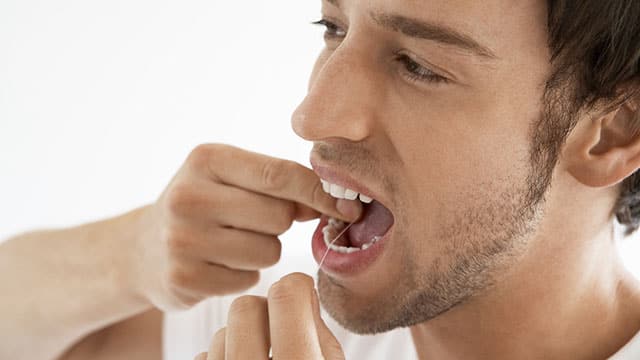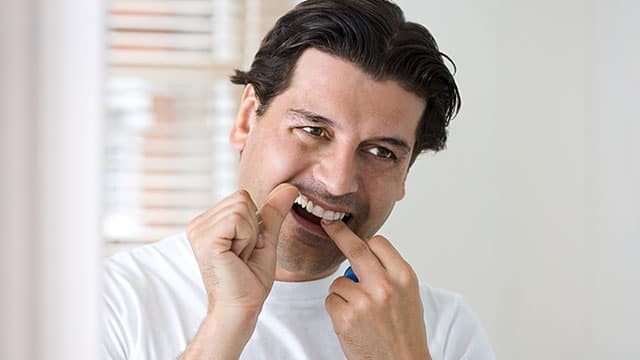Why Is Flossing Important?
What many people refer to as simply flossing is something we prefer to call cleaning between your teeth (or interdental cleaning). Floss is just one of many tools you can use to accomplish this important daily task! The important thing is not that you use floss, but that you adequately clean the sides of your teeth and the area between them every day using an effective method.
Cleaning between your teeth may help maintain your oral health in two main ways. First, it dislodges trapped debris and food matter in difficult-to-reach areas. Second, it removes plaque (also known as biofilm) from the sides of your teeth. Removing plaque is crucial to your oral health, as it contributes to many dental problems if left unchecked.
Failing to clean between your teeth adequately may contribute to:
- Tartar: Removing plaque regularly is vital to your oral health as left on your teeth, plaque will harden into tartar. Once this occurs, you will not be able to clean it on your own but will require the help of your dental professional.
- Gum disease: Plaque and tartar can contribute to your gums becoming sensitive, inflamed, and red: symptoms of gum disease. The sooner you start flossing, the better. Early-stage gum disease (also known as gingivitis) is reversible, but later-stage gum disease (also known as periodontitis) is not.
- Cavities: Tooth decay from plaque can create holes (also known as dental caries) in your teeth's hard outer layer, known as the enamel. Left untreated, this can lead to pain, infection, and other oral health problems.
- Chronic disease: Chronic oral health problems have been connected to other health problems
Brushing your teeth is essential but doesn’t remove all your plaque on its own. Cleaning between your teeth is associated with a lower frequency of gum disease, cavities, and missing teeth.
Flossing Alternatives
Some people may avoid cleaning between their teeth precisely because they don’t enjoy one specific method, like using floss. If this describes you, you’re in luck! The modern world has more technologies and tools on the market than ever before to ensure you can choose the method that works best for you.
The best way to clean between your teeth is the one that you’ll actually be able to follow through on and do day in and day out. It’s a good idea to experiment and find the method that you enjoy most. If you have an orthodontic appliance, difficulty reaching certain areas, or simply don’t enjoy one method, rest assured other options are available.
Methods to properly clean between your teeth may include:
- Traditional floss: Also called string floss, this variety comes waxed or unwaxed in a long spool. You can remove sections at a time and thread them between your index fingers before use.
- Dental picks: This convenient disposable option typically consists of floss that’s pre-attached to a plastic handle, so you don’t need to thread it between your fingers. Be sure not to reuse these as they’ll be covered in bacteria after cleaning.
- An interdental brush: These helpful tools are similar to small toothbrushes. These may make it easier to clean difficult-to-reach areas of your mouth, especially if you have tiny gaps between your teeth or an orthodontic appliance.
- Flossing devices: There are many alternatives to flossing available for purchase, including water flossers that have gained recent popularity. Some enjoy water flossing over traditional options for its convenience, accessibility, and comfort. Another option to consider is floss threaders that make it easier to clean between your teeth if you have an orthodontic appliance.
Whatever option attracts you most, be sure to select a product with the American Dental Association Seal of Acceptance to ensure that professionals accept it. An interdental cleaning product must be more effective than brushing on its own and safe for use without damaging your mouth to gain approval.
Helpful tip: While it can be tempting to use other items to clean between your teeth, doing so is not recommended. Be sure not to use utensils, safety pins, or other methods that could damage your teeth.
Building the Habit
If you currently don’t have a habit of cleaning between your teeth, not to worry. Now is the best time to start a new routine that you can maintain for the rest of your life to prevent oral problems and keep your smile in top shape.
If flossing is uncomfortable or causes bleeding at first, don’t let this discourage you. Be sure to floss gently, as removing plaque may help reduce gingivitis and its symptoms.
Tips to help make a habit of cleaning between your teeth may include:
- Try cleaning between your teeth at the same time every day. Choose a time that works for your schedule where you can devote appropriate attention to the task.
- Consider that a small amount of effort each day could contribute to your long-term oral health and save you visits to your dental professional in the future.
- Remember that the longer you have a routine, the easier it is to maintain.
Conducting Great Oral Hygiene
No matter what your favorite method for cleaning between your teeth is, there are some helpful tips to ensure you’re doing it adequately. As mentioned above, the most important part of cleaning between your teeth is that you do it thoroughly and every day.
Tips for maintaining a proper oral care routine may include:
- Clean between your teeth once a day using floss, a flossing device, or an interdental brush.
- To effectively clean between your teeth, bring the tool up and down gently on both sides of every tooth (even your back teeth). If you’re using floss or a dental pick, form it into a c-shape along your tooth. Be sure to go down slightly into the area between your gums and teeth.
- Don’t forget to brush! Be sure to brush gently for two minutes twice a day. It’s best to do so with a soft-bristled brush and non-abrasive toothpaste.
- Choose a balanced diet that’s low in overly sugary or acidic items.
- Visit your dental professional regularly.
You’ve made a great choice to inform yourself on the benefits and methods of cleaning between your teeth and how to do so effectively. Rest assured that many who used to dislike cleaning between their teeth found a tool that worked for their needs and soon built a rewarding daily habit.
This article is intended to promote understanding of and knowledge about general oral health topics. It is not intended to be a substitute for professional advice, diagnosis or treatment. Always seek the advice of your dentist or other qualified healthcare provider with any questions you may have regarding a medical condition or treatment.
ORAL HEALTH QUIZ
What's behind your smile?
Take our Oral Health assessment to get the most from your oral care routine
ORAL HEALTH QUIZ
What's behind your smile?
Take our Oral Health assessment to get the most from your oral care routine














